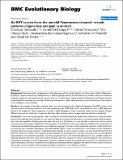Files in this item
An EST screen from the annelid Pomatoceros lamarckii reveals patterns of gene loss and gain in animals.
Item metadata
| dc.contributor.author | Takahashi, T. | |
| dc.contributor.author | McDougall, C. | |
| dc.contributor.author | Troschianko, J. | |
| dc.contributor.author | Chen, W-C. | |
| dc.contributor.author | Nagarajan, A.J. | |
| dc.contributor.author | Shimeld, S.M. | |
| dc.contributor.author | Ferrier, David Ellard Keith | |
| dc.date.accessioned | 2014-04-28T10:01:01Z | |
| dc.date.available | 2014-04-28T10:01:01Z | |
| dc.date.issued | 2009-09-25 | |
| dc.identifier | 462370 | |
| dc.identifier | d3cafb6c-0064-444c-bc3b-a9656baed4cc | |
| dc.identifier | 70350294672 | |
| dc.identifier.citation | Takahashi , T , McDougall , C , Troschianko , J , Chen , W-C , Nagarajan , A J , Shimeld , S M & Ferrier , D E K 2009 , ' An EST screen from the annelid Pomatoceros lamarckii reveals patterns of gene loss and gain in animals. ' , BMC Evolutionary Biology , vol. 9 , 240 . https://doi.org/10.1186/1471-2148-9-240 | en |
| dc.identifier.other | standrews_research_output: 31697 | |
| dc.identifier.other | ORCID: /0000-0003-3247-6233/work/36423835 | |
| dc.identifier.uri | https://hdl.handle.net/10023/4623 | |
| dc.description | BBSRC. CM was funded by the Commonwealth Scholarship Commission and AJ-N was funded by a Dorothy Hodgkin Postgraduate Award. | en |
| dc.description.abstract | Background: Since the drastic reorganisation of the phylogeny of the animal kingdom into three major clades of bilaterians; Ecdysozoa, Lophotrochozoa and Deuterostomia, it became glaringly obvious that the selection of model systems with extensive molecular resources was heavily biased to wards only two of these three clades, namely the Ecdysozoa and Deuterostomia. Increasing efforts have been put towards redressing this imbalance in recent years, and one of the principal phyla in the vanguardof this endeavour is the Annelida. Results: In the context of this effort we here report our characterisation of an Expressed Sequence Tag (EST) screen in the serpulid annelid, Pomatoceros lamarckii. We have sequenced over 5,000 ESTs which consolidate into over 2,000 sequences (clusters and singletons). These sequences are used to build phylogenetic trees to estimate relative branch lengths amongst different taxa and, by comparison to genomic data from other animals, patterns of gene retention and loss are deduced. Conclusion: The molecular phylogenetic trees including the P. lamarckii sequences extend early observations that polychaetes tend to have relatively short branches in such trees, and hence are useful taxa with which to reconstruct gene family evolution. Also, with the availability of lophotrochozoan data such as that of P. lamarckii, it is now possible to make much more accurate reconstructions of the gene complement of the ancestor of the bilaterians than was previously possible from comparisons of ecdysozoan and deuterostome genomes to no n-bilaterian outgroups. It is clear that the traditional molecular model systems for protostomes (e.g. Drosophila melanogaster and Caenorhabditis elegans), which are restricted to the Ecdysozoa, have undergone extensive gene loss during evolution. These ecdysozoan systems, in terms of gene content, are thus more derived from the bilaterian ancestral condition than lophotrochozoan systems likethe polychaetes, and thus cannot be used as good, general representatives of protostome genomes. Currently sequenced insect and nematode genomes are less suitable models for deducing bilaterian ancestral states than lophotrochozoan genomes, despite the array of powerful genetic and mechanistic manipulation techniques in these ecdysozoans. A distinct category of genes that includes those present in non-bilaterians and lophotrochozoans, but which are absent from ecdysozoans and deuterostomes, highlights the need for further lophotrochozoan data to gain a more complete understanding of the gene complement of the bilaterian ancestor. | |
| dc.format.extent | 17 | |
| dc.format.extent | 949870 | |
| dc.language.iso | eng | |
| dc.relation.ispartof | BMC Evolutionary Biology | en |
| dc.subject | QH426 Genetics | en |
| dc.subject.lcc | QH426 | en |
| dc.title | An EST screen from the annelid Pomatoceros lamarckii reveals patterns of gene loss and gain in animals. | en |
| dc.type | Journal article | en |
| dc.contributor.institution | University of St Andrews. School of Biology | en |
| dc.contributor.institution | University of St Andrews. Marine Alliance for Science & Technology Scotland | en |
| dc.identifier.doi | 10.1186/1471-2148-9-240 | |
| dc.description.status | Peer reviewed | en |
| dc.identifier.url | http://www.scopus.com/inward/record.url?scp=70350294672&partnerID=8YFLogxK | en |
This item appears in the following Collection(s)
Items in the St Andrews Research Repository are protected by copyright, with all rights reserved, unless otherwise indicated.

